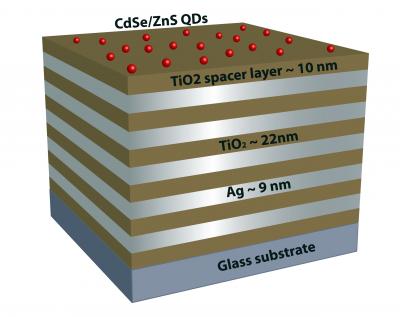A multi-institute research team has developed a novel nanostructured metamaterial that can transmit light more efficiently, taking one step closer to the realization of novel optical technologies.
 This graphic depicts a new "nanostructured metamaterial" - layers of silver and titanium oxide and tiny components called quantum dots - to dramatically change the properties of light. (Image courtesy of CUNY)
This graphic depicts a new "nanostructured metamaterial" - layers of silver and titanium oxide and tiny components called quantum dots - to dramatically change the properties of light. (Image courtesy of CUNY)
The institutes involved in the work included Purdue University, Queens and City Colleges of City University of New York (CUNY), and University of Alberta. Purdue and Alberta researchers carried out the theoretical work and the CUNY team led the experimental study. The study results were reported in the journal, Science.
The metamaterial consists of alternative layers of titanium oxide and silver as well as quantum dots. The novel material is capable of modifying the properties of light significantly. Light traversing this metamaterial turns out be hyperbolic, which in turn improves the output of light emitted by the quantum dots. These materials show promise in the development of advanced LEDs, solar cells and powerful quantum information systems.
Evgenii Narimanov of Purdue University explained that modifying the surface topology by metamaterials paves a new way for light control. These metamaterials can allow the use of single photons, which are small light particles, for routing and switching in next-generation computers. Although photons can drastically increase the speed of telecommunications and computers, the size of traditional photonic devices cannot be reduced further due to the fact that light wavelength is not small enough to fit in small components required for ICs.
However, the size of light wavelength and photons can be reduced using these nanostructured metamaterials, thus enabling the fabrication of new class of nanophotonic devices, said Narimanov.